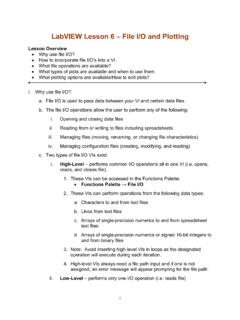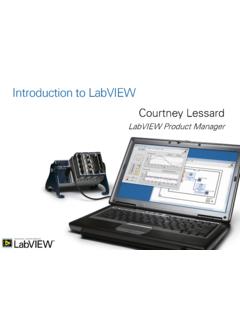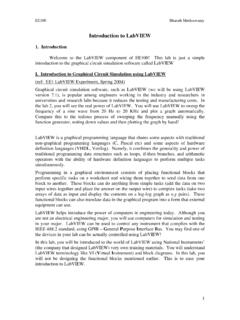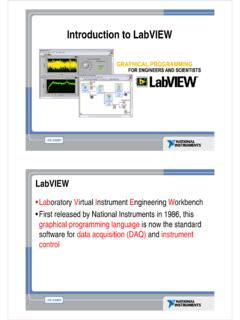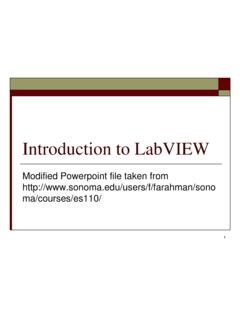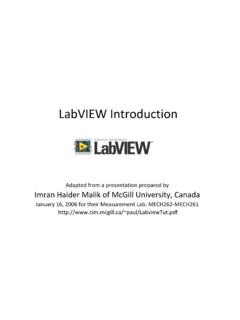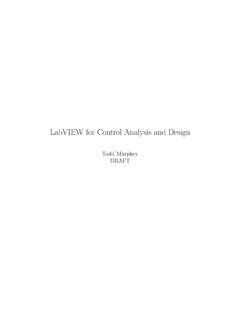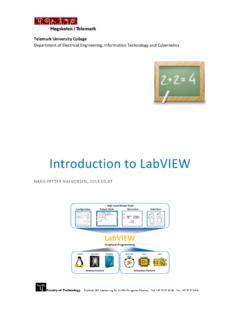Transcription of LabVIEW Lesson 1 – Introduction to LabVIEW
1 1 LabVIEW Lesson 1 Introduction to LabVIEW Lesson Overview How to access LabVIEW . How to create a new blank VI. How to create a front panel with the available controls and indicators. How to create a block diagram that corresponds to the front panel. How to use the tools palette and available house-cleaning functions on the toolbar. I. Accessing LabVIEW a. Logon on to computer b. From the Start menu, Select Programs National Instruments LabVIEW (or whatever version is on your computer) LabVIEW c. Select OK for the Security Notice and Continue on the LabVIEW window II. Creating a new blank VI (Virtual Instrument) a. What s a VI? i. A virtual instrument or LabVIEW program ii.
2 It is referred to as a VI because its appearance and operation resembles physical instruments ( oscilloscopes and multimeters) b. Opening a new blank VI i. The following screen will appear and the majority of the time, you will either choose New or Open: 2 1. The New button allows you to create a new VI 2. The Open button allows you to open an existing VI ii. Click on the New button to create a new VI. iii. On the next screen, make sure that under the Create New: menu Blank VI is highlighted and then, click on OK. iv. You will now have two main windows on your desktop, a front panel (gray grid background) and a block diagram (white background). 1. The Front Panel is similar to the dashboard instrument panel in your car as it will contain all the visual indicators and inputs.
3 A. The controls and indicators that may be placed on the front panel are located in the Controls Palette (if not already displayed, Right-Click on the Front Panel and to make it stay on the screen, Left-Click on the Push-Pin in the upper left corner). b. The Controls Palette may only be used for the front panel and is where you will select different controls (inputs) and indicators (outputs). i. Controls will have knobs, push buttons, dials, and other input devices. 3 ii. Indicators will be graphs, LEDs, numeric display, and other output displays. 2. The Block Diagram is a graphical source code, much like a circuit board, used control the front panel objects.
4 A. The Block Diagram includes objects such as terminals (representing the front panel objects) and those items that don t show on the front panel such as functions, constants, and wires to connect all of the objects. b. The palette that contains all of these objects is the Functions Palette, which again can only be used in conjunction with the Block Diagram (if not already displayed on your screen, Right-Click on the Block Diagram and to make it stay on the screen, Left-Click on the Push-Pin in the upper left corner). 3. To switch from the Front Panel to the Block Diagram, either use the mouse and Left-Click on whichever window you would like or press Ctrl-E. 4. In addition to the Controls and Functions Palettes, the Tools Palette is a universal palette that can be used to perform operations on both the Front Panel and Block Diagram.
5 4 a. To access the Tools Palette if not already displayed, go to Window Show Tool Palette; if not an option, Click on the arrow. b. Use the Tools Palette to switch cursor operation modes ( wiring, creating text, selecting items, entering values). III. EXAMPLE : Creating a Simple Addition VI a. This VI will add two numbers or input values (A and B) and return the sum, C. b. Beginning with the Front Panel, i. Insert a Numerical Control by .. Controls Palette Num Ctrls Num Ctrl Front Panel (to place the numerical control). ii. Copy the first Numerical Input by .. Choose the Arrow from the Tools Palette Hold down Ctrl and Left-Click on the Numerical Control Drag to the second input s desired position (right below the first).
6 Iii. Insert a Numerical Indicator by .. Left-Click on the Arrow to go back to the main Controls Palette Num Inds Num Ind Front Panel to place the Numerical Indicator in its desired position. iv. Change the titles of the inputs and outputs by changing from the arrow to the text editor . Left-Click on each title Highlight the previous text and Delete, Type in new text. v. Horizontally align the inputs and vertically align one of the inputs with the output. 1. Change back to in the Tools Box and Highlight the two inputs (A and B) by Dragging a box around them Left-Click Icon at the top of the Front Panel Left Edges Icon . 5 2. Drag a box around one of the inputs and the output to select both Icon Top Edges Icon.
7 C. Ctrl-E to switch to the Block Diagram (three terminals should be displayed, two for the inputs and one for the output). i. Insert an Add Function by .. Left-Click on Arith/Compare in the Functions Palette Numeric Add Block Diagram to place the Add Function. ii. Connect each Input to an Input Terminal on the Add Function triangle by .. Select the Wire Icon from the Tools Palette Left-Click on one of the Inputs one of the Add Function terminals (wire will turn orange when connected). Do the same for the other input and output. iii. Check if the VI is complete by .. Observing whether a Broken Arrow or a Solid Arrow is displayed at the top left on either the Front Panel or the Block Diagram.
8 A Broken Arrow indicates that an error is present or everything is not wired correctly. A Solid Arrow indicates that the VI is completed and ready to run. d. If a Solid Arrow is displayed, Ctrl-E back to the Front Panel and input a 4 and a 7 in the two Numerical Controls (inputs) by using the Finger Icon to either Left-Click the buttons on the control or Left-Click where the numbers are and type in the appropriate number. e. Finally, Left-Click on the Solid Arrow to run the VI and ensure that the Numerical Indicator (output) reads 11. f. The VI should look similar to the Figures and on the next page: 6 Figure : Front Panel of Simple Addition VI Figure : Block Diagram of Simple Addition VI IV.
9 EXAMPLE : Exploring Signal Generation and Processing a. This example shows how to create/simulate a sinusoidal input signal, use numerical controls to change the amplitude and frequency of the sinusoidal waveform, and display the sinusoidal waveform. b. To create a signal: i. Left-Click on Controls Simulate Simulate Signal and place on block diagram. (This should bring up a setup screen as shown on the next page in Figure to configure the type of input signal you want to simulate.) 7 Figure : Configuration Window for Signal Simulation You can choose the type of signal you want (sinusoidal, square, triangular, etc.) as well as the frequency, amplitude, phase, offset, and noise if desired.
10 Ii. Click OK when you have all the parameters set as desired (we will just leave them as is for now). iii. Now we need to add an output graph so that we can see our signal. Go to the Front Panel and choose from the Controls Palette Graph Inds Waveform Graph . iv. We also want the user to be able to control the frequency and amplitude of the sinusoidal waveform without having to open up the configuration screen. Add Two Numerical Controls to the Front Panel and label them Frequency and Amplitude . Your Front Panel should now look similar to Figure on top of the next page. 8 Figure : Front Panel of Signal Generation VI v. Now switch back to the Block Diagram and now we need to connect the two controls to the Simulate Signal block.
